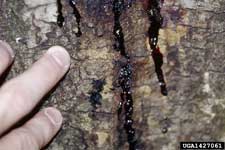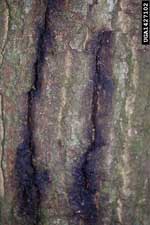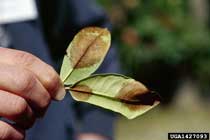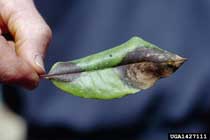Phytophthora ramorum
Department of Crop Sciences
University of Illinois at Urbana-Champaign
P. ramorum causes a wide range of symptoms on forest and nursery plants. In general, symptoms are of two types: 1) bark cankers that may kill the host and 2) foliar blights that may serve as a reservoir for the pathogen - a place for the fungus to form spores that may move to other plants. The cankers are generally associated with hosts in the oak family while the foliar blights occur mostly on shrubs with a few other tree hosts.
P. ramorum causes rapid decline and death of California oaks, usually resulting in death in 1 to 3 years. On oak, the disease causes a bleeding canker on the stems or trunk. You might also see similar bleeding cankers on Illinois oaks; but the sudden oak death cankers ooze a black or reddish fluid, and the wood under them has black zone lines evident when bark is removed. Once crown dieback begins, the leaves turn brown in a few weeks. On oak these symptoms might be confused with oak wilt, oak decline, and red oak borer injury. See the following link for a pest alert for Sudden Oak Death that includes photos of P. ramorum symptoms.


P. ramorum bark canker symptoms on Coast Live Oak (Q. agrifolia)
Source: Joseph O'Brien, USDA Forest Service, www.invasive.org
The foliar symptoms include gray to brown to purple lesions on the leaf blade, petiole, or stems. The lesions usually do not have a distinct border. Symptoms on shrubs can easily be confused with other leaf blights, shoot blights, and early defoliation and/or plant death. In fact, there are other Phytophthora species that do occur as foliar blights on shrubs in Illinois and are visually indistinguishable from sudden oak death/P. ramorum blight. Laboratory testing is the only way to prove the presence of the P. ramorum pathogen. Some images of P. ramorum blight can be found at www.suddenoakdeath.org. The USDA APHIS site also has a PDF document titled Symptoms of P. ramorum with images.


P. ramorum foliar symptoms on Rhododendron
Source: Joseph O'Brien, USDA Forest Service, www.invasive.org
P. ramorum is impossible to positively diagnose on-site (even for a trained plant pathologist) and it is easily confused with other less important diseases and disorders. For this reason, we have provided several screening questions to help you determine which suspect samples should be submitted for P. ramorum testing.